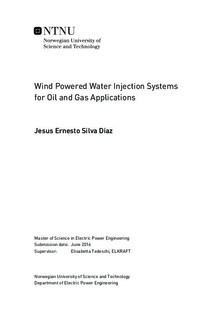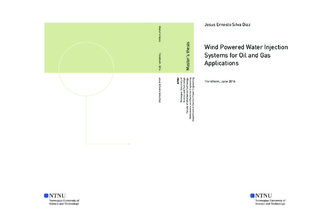| dc.description.abstract | The project is focused on the modelling and control of water injection systems (WIS) in oil and gas (O&G) facilities powered by wind turbines. The use of wind power for WIS has been presented by DNV-GL as an sustainable, environmentally friendly solution, while at the same time keeping is economic feasibility according to initial findings [1]. The fundamental assumption for presenting this concept is related to the flexibility of WIS to increase and decrease the load demand depending on the available power. Some of challenges identified are the frequency and power balance, wind intermittency and impacts on the system stability and the effective load control. This work addressed these challenges by a mathematical modelling of the system components and by testing the assembled configurations in different wind scenarios, exploring the systems response on the mentioned variables of interest.
The first part of the thesis works with two models. The hybrid WIS model and the stand-alone WIS model. The hybrid WIS configuration is a representation of a dual system that uses a gas turbine and a wind turbine. In other words, the hybrid model is a representation of an O&G platform that integrates wind power. The use of wind power for WIS in O&G platforms is an alternative used proposed here for reducing CO_2 emissions, increasing installed capacity and wind penetration without compromising the system functioning .The ordinary approach has been to assume an inflexible load and a predominance of gas units. The gas turbines must be able to provide for the demand at each instant in case of wind power deficit, leading to large dependency and frequent on and off cycles on the generators. The new approach developed here, is to incorporate load control on the existing system and to understand the advantages of load management, when dealing with wind power fluctuations. The load control is applied to specific equipment as for example injection pumps or non-priority loads. The hybrid model is composed of four subsystems. The wind turbine, the gas turbine, the fixed and flexible loads and the dump load subsystem. The wind turbine subsystem is composed of a wind turbine, made of a direct-drive permanent magnet synchronous generator (PMSG), a rectifier, a crowbar protection circuit, an inverter and a filtering inductance. The gas turbine subsystem drives a synchronous generator with an excitation circuit. The fixed load is a three-phase balance load defined in terms of active and reactive power and a flexible load controlled by an external power balance loop. Finally, the dump load subsystem is represented by a regulating resistor bank. The second dynamic model is composed of five subsystems, it is called here stand-alone WIS configuration. The wind turbine, the synchronous flywheel, the fixed load, the dump load and a variable speed drive connected to an induction motor. This configuration is a double back-to-back system proposed in a previous specialization project. The new component is the synchronous flywheel that sets the system frequency, and is also responsible for providing active and reactive power to balance the network. Another project contribution is the full implementation of the VSD with pump torque profile as mechanical load.
The generalized VSC control framework is used for developing control of the different IGBTs. Firstly, a simplified control of rotor speed and maximum power extraction from the wind turbine on the rectifier is implemented. Secondly, the inverter control objective is on the DC voltage and to be compliant with the grid requirements. Thirdly, the dump load control was based on frequency measurement and varying conductance changes in the ballast load. Finally, the second back-to-back converter (VSD) implements an improved field-oriented control strategy with respect to the specialization project. The improvement consists of the installation of front-end rectifier that allows a bidirectional power flow. In other words, instead of burning energy every time the motor should break, the power is fed back to the grid, which is known as regenerative breaking.
The second part of the thesis implements an energy model in HOMER (Hybrid Optimization of Multiple Energy Resources) Energy . This model was developed as a validation for long-term assessment in a different time scale, wind resource evaluation in a specific region near to Trondheim, and as a feasibility test of load management for WIS. This software is specialized in microgrids and energy studies. The study uses real wind profile downloaded from NASA surface meteorology database. The wind speed was measured at 50m above the earth surface, and it was corrected to the hub height. The measurements were monthly average values in a 10-year period. The system simulated consists of a wind turbine, a flexible load and a battery bank. The wind turbine is a 6MW turbine, with a load of 3.5MW of peak demand and a 500kW battery bank. The load profile was synthetized following the generation curve of the wind turbine, representing an adaptable load. The dynamic simulations confirmed that it is possible for the load to follow the wind generation within its permissible operating range. Two cases were run on HOMER, one for high wind (12m/s) and another for low wind condition (8.66m/s). The simulations consisted in sensitivity and optimization analyzes. Under the user-specified constraints, the program optimized at the lowest total net present cost, varying fuel cost, number of batteries, number of wind turbines, etc. and then selects the best configuration. Besides obtaining useful technical information, long-term energy assessment studies are required for determining the economics of a particular project. However, due to lack of investment costs, economic analyses are out of scope in this report. | |

